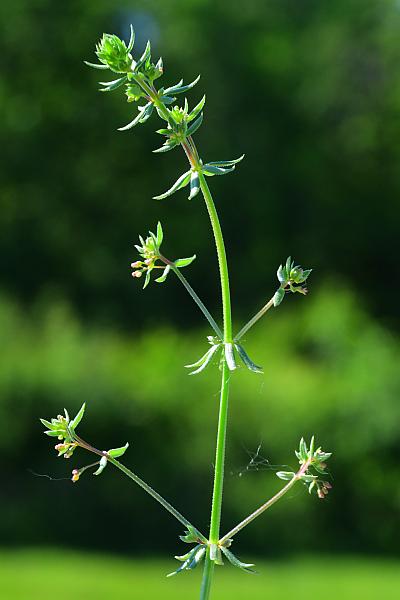Galium anglicum Huds.
Wall Bedstraw

Introduced
CC = *
CW = 5
MOC = 8
© SRTurner
Galium anglicum Huds.Wall Bedstraw | |
 |
Introduced CC = * CW = 5 MOC = 8 |
© SRTurner |
|
Family - Rubiaceae
Habit - Annual forb, sometimes becoming slightly hardened at the base at maturity.
Stems - Ascending to erect, usually weak, sometimes clambering, often branched and/or tufted, 4-angled, roughened with minute, prickly, downward-curved hairs on the angles.
Leaves - Whorled, sessile, usually 4-6 per node, spreading or downward-angled in orientation. Leaf blades 1-6 mm long, 0.5-2.0 mm wide, narrowly elliptic to narrowly oblong or linear, angled or short-tapered to a sharply pointed tip, the midvein sometimes extended into a minute, sharp point, angled to truncate at the base, not glandular on the undersurface, with only the midvein visible, the margins with minute, stiff, prickly hairs and usually curled under.
Inflorescences - Terminal and axillary from the uppermost leaves, the axillary ones not pendant, positioned over the leaves, consisting of small clusters, these usually grouped into small panicles with mostly 2 or 3(4) branch points and relatively short, ascending to less commonly spreading branches.
Flowers - Relatively few, the stalks 0.5-2.0 mm long. Corollas 0.4-0.6 mm long, 4-lobed, white. Fruits - Schizocarps about 1 mm long, 1.5 mm wide, 2-lobed, the surface glabrous, smooth to granular.
Flowering - May - June. Habitat - Glades, ditches, cemeteries, lawns, open disturbed areas. Origin - Native to Europe. Lookalikes - G. divaricatum; also other small species of Galium, including G. virgatum and G. concinnum. Other info. - This small introduced bedstraw is uncommon in Missouri, known so far from only a few counties, mostly in the southern part of the state. It has also been found in a few widely scattered locations in the southeastern and northwestern regions of the continental U.S. Being very small with minute flowers, the plant is very easily overlooked. Once found it is identifed by its very small, whorled nodes of typically 6 leaves, and inflorescence branches which ascend from the main stem. Individual flowers (or fruits) are usually 2-3 branch points out in the inflorescence. The fruits are glabrous and lack the hooked bristles which characterize several more common species in the genus. Photographs taken at Weldon Spring Conservation Area, St. Charles County, MO, 6-2-2020 (SRTurner). |